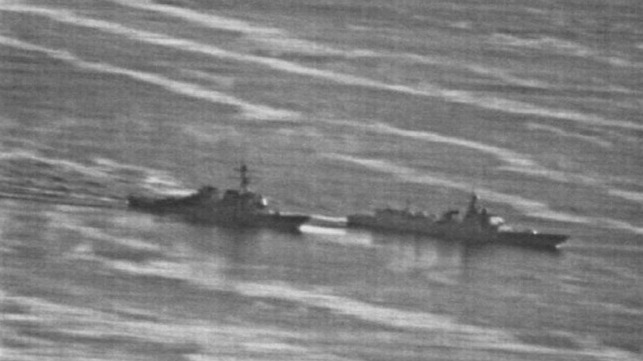Naval Encounters the "New Norm" in the South China Sea

The release of video footage from the bridge wing of USS Decatur which shows its recent close encounter with the Chinese destroyer Lanzhou in the South China Sea confirms the judgement that the PLA Navy ship did not act wisely in its approach to the US Navy unit in response to the latter’s freedom of navigation operation.
Lanzhou came upon the American ship from astern, making it the “burdened” vessel under the International Regulations for the Prevention of Collision at Sea (COLREGS), passed up Decatur’s port side and moved ahead on a slowly converging course that would have eventually crossed ahead of the Decatur’s track.
The US Navy estimated that the closest point of approach was 45 yards, a figure that seems accurate from the video evidence.
After Lanzhou moved far enough ahead, the Decatur sensibly did a “dogleg” to starboard to shift its intended course clear of the PLA Navy ship and then resumed its transit of the claimed Chinese waters to assert its right of innocent passage of the territorial sea without the requirement of prior notification.
Contrary to some media descriptions, the situation never approached what is described at sea as “in extremis”. The body language of the US Navy officers visible in the video suggests they felt in control. Provided there were no sudden moves – and no failures of equipment – the ships remained clear of each other in what were ideal environmental conditions.
Nevertheless, Lanzhou’s handling of the situation was less than adept.
Apart from the fact that the Chinese ship had the responsibility under the COLREGS to keep out of Decatur’s way “until finally past and clear”, moving forward of the American as it did effectively rob Lanzhou of the initiative. The new geometry meant that any physical encounter which followed was much more likely to result in severe damage to the Chinese ship than the American, whose bow would take the brunt of any collision.
The incident is a reminder that naval encounters are the new norm in the South China Sea. It will, however, be important not to read too much into any particular exchange. Decatur was engaged in a freedom of navigation operation which was directly challenging Chinese interpretation of the Law of the Sea – not, it should be emphasised, making any comment on the legitimacy of China’s claims to any land features in the South China Sea.
Lanzhou’s language in promising “consequences” if the Decatur continued its transit was certainly threatening but sufficiently vague to suggest that the PLA Navy commanding officer did not have the authority to escalate the situation further. The manoeuvring was awkward but fell far short of playing maritime “chicken”.
The PLA Navy clearly intends to shadow any other national force operating in the area. This was the case most recently for the Japanese task group formed around the helicopter carrier Kaga, which deployed to the South China Sea last month. Australian ships have also been shadowed and we can expect this to become more frequent as the Royal Australian Navy increases its presence in the region.
Yet navies shadow other navies all the time in other parts of the world if there are strategic or operational reasons to do so. These activities do not need to be cause for concern in themselves. Some such work will be straightforward intelligence gathering – every US or NATO battle group had its Soviet “tails” during the Cold War.
Sensible intelligence gatherers soon realise that manoeuvring in ways which upset the subjects of their attention is largely counter-productive since this often impedes the operations which are the focus of interest. Professional relationships and mutual understanding eventually develop between shadower and shadowed.
Other forms of shadowing (British efforts to monitor the transits of Russian warships through the English Channel are typical) relate to the demonstration of a national presence. China’s naval activities in the South China Sea will have both assertion of its claims to sovereignty and intelligence gathering as motivations, with the sovereignty element – and the accompanying possibility of hazardous interactions – becoming more significant the closer the activity to China’s claimed territorial waters.
But there is a third element to shadowing, perhaps the most important one for the PLA Navy in the South China Sea, that is distinct from formal claims to sovereignty: demonstration of military capability. China will see the persistent presence of its units accompanying any foreign force as confirmation of its ability to achieve military domination of the sea areas concerned.
In Chinese military strategy, achieving this goal is much more important, if requiring more subtlety, than expansive claims to sovereignty over the “blue land” of the South China Sea. For other nations, whether China’s capabilities are recognised or not, the important thing will be to maintain sufficient levels of activity that China can never consider the area closed to other navies.
James Goldrick AO, CSC is a Nonresident Fellow at the Lowy Institute. He joined the Royal Australian Navy in 1974 and retired in 2012 as a two-star Rear Admiral. He commanded HMA Ships Cessnock and Sydney (twice), the multinational maritime interception force in the Persian Gulf and the Australian Defence Force Academy. He led Australia’s Border Protection Command and later commanded the Australian Defence College.
This article appears courtesy of The Lowy Interpreter and may be found in its original form here.
The opinions expressed herein are the author's and not necessarily those of The Maritime Executive.
